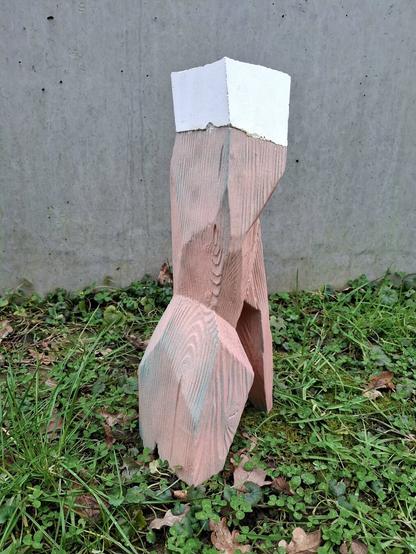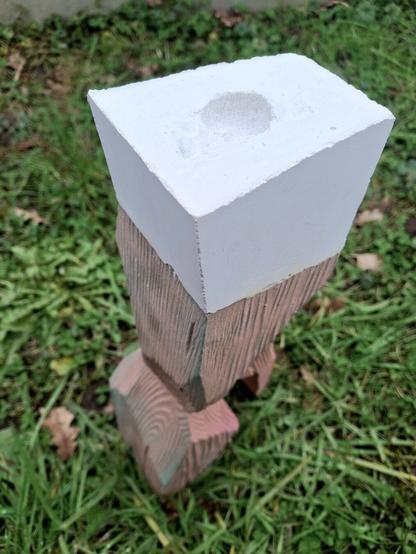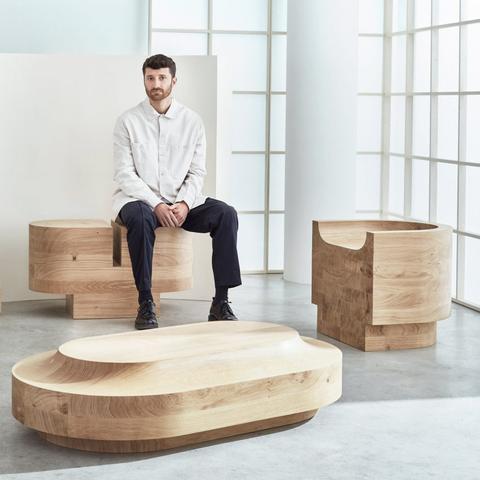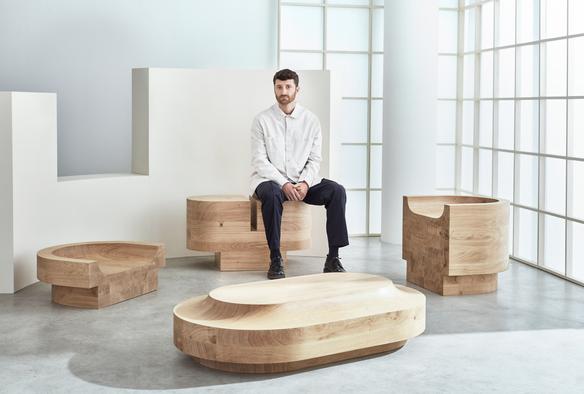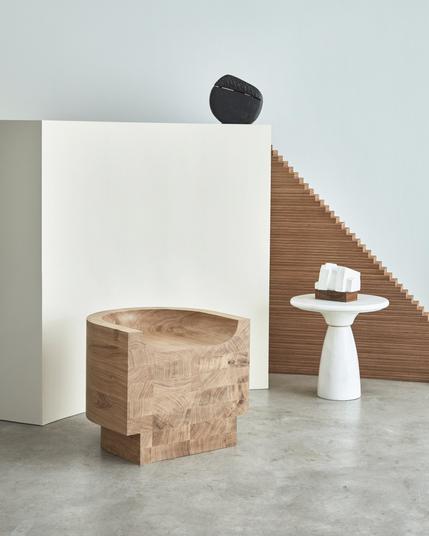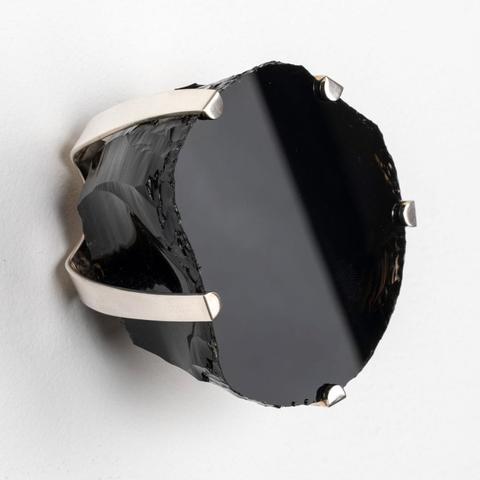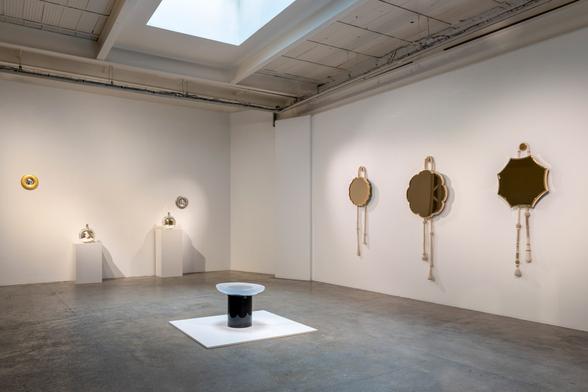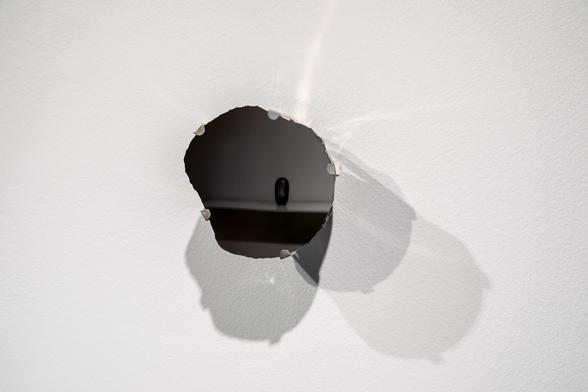#collectibledesign
Detail of the texture. I'm so in love with this laquered wood.
#texturephotography #woodworking #furnituredesign #collectibledesign
Reclaimed wood, concrete, laquer.
27x20x13 cm.
An ingoing investigation in sculptural identities and their functionality.
Where does the functional object end and where does the artwork begin. Is there a distinct border between the two?
What is figurative, what is abstraction. How abstracted can the figure be before it loses it's meaning? And -more importantly - when does the spectator start to give meaning to the abstraction? When does the shapeless blob become the figure?
Thus, ongoing investigation.
#functionalart #spomenik #collectibledesign #brutalistsculpture #artconcret #benjaminpattin
.
.
.
#cicagomez
#ceramic
#rose
#ContemporaryCeramics
#MinimalCeramics
#HandmadeLuxury
#CeramicDesign
#WheelThrownCeramics
#SlowMade
#WabiSabiAesthetics
#TimelessDesign
#CeramicArtDaily
#CollectibleDesign
#DesignLovers
#ArtisanatDArt
#InteriorStyling
#TeaTimeAesthetic
#ElegantLiving
#MinimalismLover
#TablewareDesign
#QuietLuxury
#france
#lyon
Benni Allan brings precise curves to solid oak with Low Collection
London design gallery Béton Brut is presenting a series of sculptural, curved furniture pieces made from solid oak, designed by EBBA Architects founder Benni Allan.
The Low Collection is made up four objects: a low seat, a high seat, a two-person bench and a low table.
The Low Collection is on show at the Béton Brut gallery in London
Allan's intention was to respond to forms of "low sitting" that exist around the world, inspired by his background living in China and Spain and his travels in Japan.
Each piece suggests a different way of sitting than a traditional chair or table.
Each piece is made from solid oak
"I'm interested in how different people sit," explained the London-based architect.
"A lot of countries have a strong tradition of being very low, sitting on the floor," he told Dezeen.
"My idea was to make objects that question what you do with them, so not necessarily prescribing a use but doing something that forces you to engage in a certain way."
The forms are based around the concept of "low sitting"
The Low Collection was produced from high-quality, kiln-dried oak, which was milled using a specialist CNC machine to create precise geometries.
For each piece, specific curvatures are combined with strict horizontal or vertical lines. Where pieces have been cross-cut, the end grain of the wood creates a grid of distinct patterns.
[
Read:
Nathalie Deboel creates minimalist furniture using simple wooden poles
](https://www.dezeen.com/2021/01/12/nathalie-deboel-nomad-minimalist-furniture/)
"The scale of each one is designed to maximise the thickest oak that we could obtain," said Allan.
"The great thing about the material is that it really changes depending on the geometry," he added. "The pieces are very solid, the geometry really softens them."
The designs combine straight lines with precise curves
Allan is considered a rising star in the architecture world, thanks to his resourceful approach and responsible use of materials.
This is demonstrated in EBBA projects like Construction Skills School and an apartment refurbishment in Bow.
Low Collection was a project that Allan has been working on by himself. He hadn't expected the designs to become a reality, until Béton Brut founder Sophie Pearce suggested they work together to produce the pieces.
A specialist CNC machine was used in the production
Béton Brut typically only deals with vintage works from the early and mid-20th century, but Pearce felt the works could hold their own against some of the classics.
"Never have such works in wood excited me since Axel Einar Hjorth’s Utö stool from 1932 or Lina Bo Bardi’s side chair for the centre SESC Pompéia from 1980," she said.
Low Collection is on show at Béton Brut gallery from 25 May to 8 July. See Dezeen Events Guide for an up-to-date list of architecture and design events taking place around the world.
The post Benni Allan brings precise curves to solid oak with Low Collection appeared first on Dezeen.
#furniture #all #design #oak #wood #exhibitions #collectibledesign
Tradition and playfulness meet in Departures collection of Jordanian design
A vase that echoes the colours of Petra and a hot pink piggy bank shaped like a squeezed balloon are among the objects in the Departures collection of Jordanian collectible designs from gallery Adorno.
Departures features the work of 10 design studios, working with different materials and processes but all exploring the intersection between the traditional and the contemporary in Jordanian design.
The collection was curated by Amman Design Week co-founder Rana Beiruti, who wanted to challenge preconceptions that design from the region was all about "very traditional crafts and geometric patterns".
The Departures collection shows Jordanian designers combining traditional craftsmanship with contemporary sensibilities
"While the collection draws inspiration from the traditional techniques that define design in Jordan, it also shows a more contemporary side of Jordanian aesthetics that are inspired by our landscape and surroundings, where the designers have produced new forms that are fluid and curvilinear," Beiruti said.
"I wanted to show the capabilities of designers in Jordan in manipulating form and material," she added.
This mix of influences is evident in the Petra vase, part of the Kutleh repurposing project by architect Rula Yaghmour. It is made of layers of waste stone with colours that evoke the cliffs around the ancient city of Petra, and it has a sinuous form that marks a contemporary approach to traditional stone sculpting.
Many of its objects echo the colours and forms of Jordan's landscape
Landscape-inspired forms also feature in the Jarra carafe by Ammani studio Twelve Degrees. The designers wanted to revive the lost practice of cooling water through clay vessels, which was phased out when food safety standards required ceramics to be glazed but can now be reattempted with special glazing techniques.
The earthiness of these objects is offset by ones that Beiruti says are "light, fun and playful" – for instance, the brass and ceramic Money Balloon by Ahmad Jarrar, which uses ancient materials but applies them to create a rounded pink object that references both piggy banks and balloons.
There is also the decidedly space-age aluminium Jupiter coaster set by Andre Mcheileh, which the designer describes as "an intergalactic statement coasterpiece".
[
Read:
Adorno's emerging Lebanese designers collection shows country's "no-rule" culture
](https://www.dezeen.com/2018/07/10/adorno-beirut-week-2018-collection-emerging-designers/)
Jupiter was made by a local artisan who manually turned each of its parts on a mechanical lathe. Like all of the works in Departures, its makers are harnessing the expertise of Jordan's craftspeople and attempting to secure a future for its heritage industries.
According to Beiruti, this approach is a defining characteristic of the contemporary Jordanian design scene, as are environmental concerns driving the use of local and sometimes upcycled materials.
"The use of local materials is partly a result of necessity given global market conditions, but more importantly it's an intentional drive towards more sustainable practice," she told Dezeen.
"It's partly about reclaiming a connection with the land which has been lost for a generation. The earth itself is a great source of inspiration and potential for research."
There are also playful objects that show a light-hearted side to Jordanian design
The Departures collection also encompasses a gong-like suspended mirror by Far Flung, a carved marble candle holder by In Doi Doi, a soft-shaped stone side table by Suli, a chiselled wood cake stand by SNC Design Studio, a hand-felted textile wall-hanging by Ishraq Zraikat and a light, bright yellow metal coffee table by Opus Design Collective.
It includes both existing designs as well as new ones created exclusively for the collection.
The collection is presented by the Adorno digital design gallery
The collection was created with the support of the Office of Her Majesty Queen Rania Al Abdullah, the patron and supporter of Amman Design Week, and is presented in a series of digital collages that combine photos of the physical items with images of Jordan's iconic Wadi Rum desert.
Adorno is a Denmark-based gallery that often undertakes country-based collections and has previously featured Jordan's neighbour Lebanon.
It also once presented an exhibition of Swedish design that was characterised by being "un-Swedish".
Renders by Iñigo Inchaurraga and photography by Cielo Alejandra.
The post Tradition and playfulness meet in Departures collection of Jordanian design appeared first on Dezeen.
#furniture #all #design #homeware #jordan #collectibledesign
Front designs seven reflective objects to reveal the 8,000-year history of the mirror
Swedish design duo Front presents Seven Stories About Mirrors, an exhibition that explores the complex relationship between humans and their reflections.
On show at Galerie Kreo in Paris, the exhibition features seven mirrored objects that each represent a crucial stage in the development of the mirror, from the first ever use of reflective materials, to the evolution of glassblowing.
The exhibition features seven objects that chart the history of the mirror
Front designers Sofia Lagerkvist and Anna Lindgren hope to show the scale of progress involved in this journey, and how it mirrors the evolution of humanity.
"From the first stone mirror made 8,000 years ago, the history of mirrors is laced with magic and poetry, luxury and vanity, myth and faith, medieval industrial espionage and modern psychology, craft and technological advances, culture and self-consciousness," said the duo.
Each design represent a crucial stage in the development of the mirror
"In these pieces, we see humankind's strong desire to find the perfect reflection of ourselves," they continued.
"We also find mirrors as tools of divination, which – as well as artistic and technical achievements like the telescope and microscope – have given people the opportunity to see beyond what the naked eye can see."
Water Reflection Table was produced using a 3D scan of a water puddle
The chronology begins with Water Reflection Table, a design that evokes a natural pool of water – the natural phenomena through which humans would have first seen their reflections.
Lagerkvist and Lindgren created this by 3D-scanning a water puddle they found in a forest, which they turned into a mould for glass. Mounted as a tabletop, the glass has a lightly rippled surface, just like a real puddle.
Obsidian Mirror is a recreation of the oldest mirror in history
Obsidian Mirror is a recreation of the oldest manmade mirror in history, produced from a drawing supplied by archaeologists from Cambridge University.
The mirror is made from obsidian, a volcanic stone, set in a silver case. The stone was shaped and polished by hand using clay and water, rather than with modern tools, as it would have been 8,000 years ago.
Bronze Mirror is a trio of designs based on metal mirrors from ancient China
The historic use of metal for mirrors is reflected by Bronze Mirror, a trio of wall-hung mirrors.
Taking cues from ancient Chinese designs, these pieces feature decorative edges and are supported by a hand-crafted rope – a reference to the ribbons that wealthy people in China would use to attach these valuable objects to their clothing.
However, while their predecessors would have been made from pure bronze, which would require daily polishing, these three mirrors are actually made from bronze-tinted glass.
Convex Mirror Vase explores a technique that involved cutting a lens from a blown-glass globe
The Convex Mirror Vase tells the story of how the first glass mirrors were made in Ancient Rome, a technique that involved creating a blown-glass globe and cutting out a lens-shaped piece.
The next progression of this is shown by the Cut Mirror Vase, which shows the first technique for creating flat glass mirrors.
In the 13th century, glass would be blown into a cylinder and then unrolled, to create a flat plate. Front has created a mirrored vase that captures this process.
Cut Mirror Vase showcases the first technique used for creating flat glass
The Secret Mirror celebrates the Venetian glassmakers who moved to the island of Murano to safeguard their pioneering craft techniques, producing plate glass mirrors that were highly valued around the world.
Front collaborated with the Murano-based Barbini family, whose ancestor Gerolamo Barbini was one of the makers the Hall of Mirrors in Versailles, to create a design that showcases the craft of plate glass.
The techniques of Venetian glassmakers are celebrated in The Secret Mirror
The final piece in the exhibition brings us to the present day, where mirrors are now an everyday item.
Reflection Vase explores how a mirror image can take on a new purpose. This glass vase appears to be offering a reflection of its surroundings, when in fact – thanks to an innovative engraving technique – the image is fixed to a point in time.
Reflection Vase tricks the viewer by showing reflections that are frozen in time
Seven Stories About Mirrors is a research project that Front has been developing over the past five years.
While the design duo is best known for furniture designs they have produced for brands – for example, their Horse Lamp for Moooi, the Resting Animals for Vitra or their bent wood furniture for Gebrüder Thonet Vienna – they're also interested in a more experimental approach to design.
"We were interested to follow and understand how an object transforms its function, value and status through history," they concluded.
Seven Stories About Mirrors is on show from 20 May to 24 July at Galerie Kreo in Paris. See Dezeen Events Guide for an up-to-date list of architecture and design events taking place around the world.
The post Front designs seven reflective objects to reveal the 8,000-year history of the mirror appeared first on Dezeen.
#all #design #homeware #galeriekreo #front #exhibitions #mirrors #collectibledesign
Ultimate Collector Cars authors reveal seven of the most desirable vintage cars of all time
A new double-volume anthology presents 100 of the most collectible cars from across history. In a Dezeen exclusive, authors Charlotte and Peter Fiell pick out seven cars that top the list, including a Mercedes Benz thought to be the most valuable car in the world.
Published by Taschen, Ultimate Collector Cars showcases some of the most innovative examples of automotive design ever produced, in exquisite detail.
"It's 100 of the rarest, most desirable, most extraordinary and most collectible cars of all time," said Peter Fiell. "The total value of the cars in the book is over $1.2 billion."
"At the cutting edge of technical possibilities"
The cars featured were chosen for their rarity and exclusivity – the majority were either used as racing cars, or "homologated" from racing cars – meaning they were produced as part of the regulation process for motorsport sanctioning bodies.
In both cases, only a limited number would have been produced.
"These weren't people cars; these were cars at the absolute cutting edge of technical possibilities," said Charlotte Fiell. "Every single car in the book was pioneering in its day."
Shedding light on the secretive world of car collecting
In most cases, the car showcased in the book is the ultimate example of its type in known existence.
However, the authors point out that the locations of many historic cars are unknown, because sales are often kept behind closed doors, and many private collectors keep the contents of their collections a secret.
"We hope to shed new light onto this whole world of car collecting," said Peter Fiell. "We really wanted to share the beauty and stories of these wonderful vehicles with a wider audience," added Charlotte Fiell.
Read on for Charlotte and Peter Fiell's pick of the seven ultimate collector cars:
Photos are by Michael Furman
Alfa Romeo 8C 2900B MM Spider, 1938
For Italian automotive company Alfa Romeo, 1938 was a key season because it marked the company's return to motor racing, after several years of disbandment, and the launch of the Alfa Corse team. It was also the last year when Ferrari headed the in-house works team.
The Alfa Romeo 8C 2900B MM Spider was the racing car designed for this season, with five produced for the Mille Miglia event.
"It is generally considered the most collectible pre-war sports racing car of all time," said Peter.
This particular example is the car that was driven by race winner, Clemente Biondetti. It is owned by the Simeone Foundation Automotive Museum in Philadelphia.
Photo is courtesy of Daimler AG, Mercedes-Benz Classic
Mercedes-Benz 300 SLR "Uhlenhaut Coupé", 1955
The fastest road car of its day, the Uhlenhaut Coupé was designed by Rudolf Uhlenhaut as a coupé version of the 300 SLR race car, which Stirling Moss drove to victory in the 1955 Mille Miglia.
The car was developed for the track, but never competed because – following the Le Mans disaster that year, which involved the 300 SLR race car – Mercedes Benz withdrew from racing for the rest of that season. As a result, only two examples of the coupé were ever produced.
Both owned by the Mercedes-Benz Museum, these collector cars are distinctive for their "gullwing" doors, which open upward and outward.
"This is arguably the most valuable car in the world, and it's certainly the most valuable car in the book," said Peter.
Photo is by Tim Scott, courtesy of RM Sotheby's
Ferrari 290 MM, 1956
"This is not only one of the most gorgeous Ferraris is of all time, it's also one of the rarest," said Peter, describing the 290 MM.
Only four of these cars were ever built. This particular example is the one that Argentinian driver Juan Manuel Fangio raced in the 1956 Mille Miglia, where the Scuderia Ferrari racing team enjoyed a 1-2-3-4 finish. However, this car placed fourth, when it was expected to win.
"Fangio, who may be considered the greatest racing driver that ever lived, didn't fulfil his promise and probably felt he was letting Enzo Ferrari down," said Peter.
Luckily for Fangio, he and the 290 MM went on to win the World Sportscar Championship later that year.
Photo is by Darin Schnabel, courtesy of RM Sotheby's
Ferrari 250 Testa Rossa, 1957
With its low-slung aerodynamic form, the Ferrari 250 Testa Rossa was a controversial car. However, this lightweight body was key to the car's competitiveness – not only did it reduce drag, but it also directed air to vents that cooled the brakes.
It retained the excellent handling and reliability of the very first Testa Rossa, built the year before, but was equipped with a more powerful V12 engine.
There were 34 of these cars produced. This particular example was the winner of the 1,000 Kilometres of Buenos Aires event in 1958, but is also distinctive for another reason.
"It's a competition-winning Testa Rossa, but also it's the only black one," revealed Peter. "All the Ferraris are red, so it was particularly desirable to get this car in the book because it's unusual in its colour."
Photo is by Michael Furman, courtesy of RM Sotheby's
Shelby 427 Cobra S/C, 1966
Carroll Shelby had originally planned to race his 427 Cobra in the 1965 season, but as production was slow, he failed to meet the homologation rules that required 100 cars to be built.
Production was halted as a result, and 29 of the unused competition chassis were repurposed to create the 427 Cobra S/C (semi-competition). These street racers retained many of the race car features, including the riveted hood scoop, oil cooler, roll bar and side exhausts.
"If I could have any car in the book, I think it would be this one," said Peter.
"It's one of the most powerful, dangerous, visceral, road cars you can ever imagine. If you heard this thing, you wouldn't believe it. It's a beast."
This example is one of the few that still remain in good condition; according to the authors, most have been "hammered into the ground" by their owners.
Photo is by Kidston SA
Lamborghini Miura P400 SVJ, 1971
The Miura P400 made headlines when it was first launched in 1965, as a result of its transversely mid-mounted 60° V12 engine, which was a huge innovation at that time. It later was given a curvaceous body, designed by Carrozzeria Bertone.
"There are a lot of people that think the Lamborghini Miura is the most beautiful supercar ever designed," said Peter.
The model proved so successful that engineer Bob Wallace was able to convince company founder Ferruccio Lamborghini – who was famously reluctant to produce race cars – to develop a competition version of the car, the SV.
Although the car never made it to the track, it attracted the attention Mohammad Reza Pahlavi, the Shah of Iran and an avid car collector. Lamborghini built Pahlavi a modified version, known as the SVJ, which provided better performance and had a racier appearance. Another three were also produced, but this one remains the most collectible.
"You can say without a shadow of a doubt that this is the ultimate Miura," said Peter.
Photo is by Tim Scott, courtesy of McLaren Automotive
McLaren F1 LM, 1995
A true supercar, the McLaren F1 sports car combines high-tech materials like carbon fibre and titanium with a central driving position ahead of the engine and fuel tank, and distinctive butterfly doors.
"The McLaren F1 is still considered today to be one of the most important automotive designs in history, because of what it represented," said Peter. "It set all sorts of precedents in terms of its design and engineering."
After a race version of the F1 took four of the top five places at Le Mans in 1995, McLaren developed the LM variant, a road car that more closely resembled the track car than the original F1, thanks to race engines and weight-reduced interiors.
Only five of these F1 LMs were created, along with a single prototype known as the XP1 LM, which is the example featured here. It features a "papaya orange" finish, in tribute to Bruce McLaren's original racing colours.
The post Ultimate Collector Cars authors reveal seven of the most desirable vintage cars of all time appeared first on Dezeen.
#transport #all #design #technology #cars #collectibledesign


